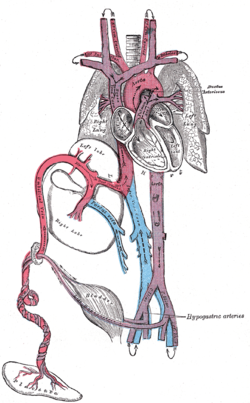Ductus arteriosus
| Ductus arteriosus | |
|---|---|
 The fetal circulatory system, with the ductus arteriosus visible at upper right. | |
| Details | |
| Precursor | aortic arch 6 |
| System | Fetal circulation |
| Source | pulmonary artery |
| Branches | descending aorta |
| Vein | ductus venosus |
| Identifiers | |
| Latin | ductus arteriosus |
| MeSH | D004373 |
| TE | arteriosus_by_E5.11.2.1.2.0.17 E5.11.2.1.2.0.17 |
| FMA | 79871 |
| Anatomical terminology | |
The ductus arteriosus, also called the ductus Botalli, named after the Italian physiologist
Development and structure
The ductus arteriosus is formed from the left 6th
Disorder: Patent ductus arteriosus
Consequences
Failure of the ductus arteriosus to close after birth results in a condition called
Role of prostaglandins
The "E" series of
Role of non-steroidal anti-inflammatory drugs
Ductus arteriosus closure may be induced by administration of
Incidence
A patent ductus arteriosus affects approximately 4% of infants with Down syndrome (DS). A failure to thrive is a very common sign of this condition.[8]
Maintaining patency
In some types of congenital heart defect (e.g.,
Other animals
Ductus arteriosus evolved with the lung in the ancestors of the lungfish as a connection between the pulmonary arteries and dorsal aorta. During embryonic development, reptiles, birds, and mammals all have either one or two paired ductus arteriosi that provide a fetal shunt of blood away from the lungs.[10]
See also
References
- S2CID 7927804.
- ISBN 9780781757652.
- S2CID 54389960.
- ^ PMID 7013675.
- S2CID 32049750.
- ^ PMID 22342504.
- PMID 22299823.
- ^ Pritchard & Korf. "Medical Genetics at a Glance". Blackwell Publishing. 2010. p63.
- ^ "Congenital heart defects: Prostaglandins and prostaglandin inhibitors". Healthwise. My Health Alberta.
- S2CID 49405282.
External links
- Circulatory changes at birth at berkeley.edu
